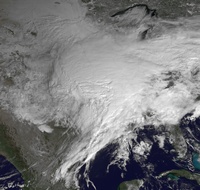
ADVERTISEMENT
The pictures of this storm are so incredible.
I think everyone is in a bit of disbelief over what the storm actually did. There are miracle stories everywhere as well.
Thank you for this article.
online casino deutschland: Wenn du nach dem besten online casino deutschland suchst, wird dich diese Casino-Software, die dir die Möglichkeit gibt, um die größte Casino-Auszahlung im Internet zu spielen, in den Glücksspiel-Himmel versetzen.
Had very little snow, but freezing rain and about 1/2" of ice coating everything overnight on Tuesday night. Then temps went up above freezing on Wednesday, in the mid-30s and high winds came and cleaned the ice off the trees. It's been very strange weather here this winter! It's supposed to be up in the high 30's tomorrow then temps fall back down and sleet and freezing rain come again on Friday night and Saturday.
Usually this time of year in the Houston area we are cleaning up fallen leaves and preparing for spring planting. Not this year - we have had two one-week spells of sub-freezing temps and no one wants to be outside longer than absolutely necessary. Water in animal troughs is frozen, even inside their barns/shelters. We're digging out clothing not worn in probably several years! I live 40 miles NW of Houston and we are expecting a couple inches of snow (winter precipitation per the weather channel). No accumulation but don't talk to be about global 'warming.' Actually the change is refreshing. :-)
I live in Southern Wisconsin. We have 10.8" on top of what we had however just south across the stateline into Illinois there is 24" on the ground. They put snowplows on the front of garbage trucks and called in extra plows. We have a four ft. drift on our patio with some cars still buried. A civil emergency was called as so many people continued to drive in spite of the 10-15 ft. drifts building up across the roads. All major roads were closed from Milwukee, WI south. Today - Thurs. - schools are still closed and many businesses are slow to open. It's been a mess but we're slowly digging out.
I live in Dundee, Mi.; (25) mi. south of the University of Mich.
3:30 a.m. It rook my son (1.5) hrs. to dig out to go to work.
5:00 a.m. It took him (1.5) hrs. to drive (45) mi. to work.
Worked (8) hrs., drove home, to rest & repeat work routine tomorrow. That's what they call "Making a Living" here in Mi.
Thank God he has a job, esp., here in Mich.
Carl Wadsworth
It was raining snow in NH--very light, very fast--but we're used to snow versus your 18 inches near Mexican border! Looking forward to awesome skiing this weekend.











